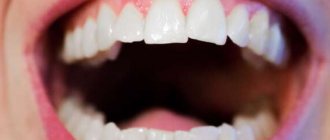Why do ulcers appear on the gums, and is it always dangerous?
There are many possible reasons. To understand how dangerous the appearance of certain lesions on the gums is, you need to look at additional accompanying symptoms:
- in case it is trivial mechanical damage. The gums can be damaged by hard food, a toothbrush, or a foreign object. These lesions may resolve in 3-5 days. If a person does not brush his teeth, then infection is added to these damages, and healing may take several weeks.
- Sometimes ulcers can appear as a result of wearing orthodontic structures, braces or removable dentures.
Causes of bumps
The formation of lumps on the gums causes an inflammatory process of soft tissues, as a result of which pus accumulates in the thickness of the gums, forming noticeable swelling. This suggests that the disease that caused the inflammation has reached an acute stage and is progressing. The most common reason for developing pus-filled or hard bumps on the gums is poor oral hygiene. But there are other sources of inflammation on the gums that a dentist can identify:
- Gingival fistula - swelling has a diameter of 3-6 mm with a white tip on the surface (an outlet for purulent contents). May be located above or below the tooth. If a fistula on the gum is not treated in time, the acute process of inflammation can become chronic.
- Periodontitis - looks like a compacted swelling; patients describe the problem as “a hard lump on the gum.” The diameter of the formation can be up to 1 cm and does not cause pain. Hard lumps appear as a result of pulpitis or unfilled teeth. If the purulent focus is not eliminated in a timely manner, it will lead to a granuloma or cyst.
- Gingivitis is a disease caused by insufficient oral care. It manifests itself as slight swelling and redness of the gums with bleeding. Therefore, the formation is often called a “red bump on the gum.”
- Periodontitis – gum tissue becomes inflamed due to the accumulation of bacteria in the gum pocket. Which, in turn, forms between the loosened tooth and the gum. Bacteria cause a purulent process and swelling in the form of a whitish lump.
- Epulis - develops as a result of mechanical trauma to the gums (unsuccessful filling, uncomfortable prosthesis, sharp edges of neighboring teeth, etc.). Globular swelling on the leg (mushroom-shaped) has a bluish tint and can reach a considerable size - up to 2.5-3 cm. Most often it affects the lower jaw and is most common among women. It can also affect the gums of children when teething for the first time.
- Hematoma - may appear after injury during tooth extraction. The swelling is watery in appearance, usually soft to the touch and may be slightly painful.
The most common diseases of the oral cavity in which ulcers appear
- ulcerative necrotizing gingivitis. The cause of this disease is bacteria that multiply when immunity decreases. Extensive ulcers appear on the gums, regional lymph nodes become enlarged, and the temperature may rise
- chronic recurrent aphthous stomatitis. Up to 4-5 white spots first appear in the mouth, which later turn into ulcers. There is no temperature or other problems related to well-being. If such symptoms appear 1-2 times a year in small quantities, then there should be no cause for concern. Frequent occurrence is associated with weakened immunity and possible intestinal diseases, as well as allergies.
- acute herpetic stomatitis. Herpetic stomatitis occurs in a child when he first encounters the herpes virus. Many bubbles appear on the gums, which, after bursting, turn into ulcers that merge with each other. The gums are always bright red, and the ulcers themselves are very painful, the temperature may rise
What to do after surgery
The recovery period after removing an overgrown root, as a rule, is longer. This is due to the need to cut the gums. Medicines are selected by the doctor individually, depending on the initial condition and complexity of the operation. Typically prescribed:
- Anti-inflammatory drugs. The doctor may prescribe oral anti-inflammatory drugs and rinses.
- Painkillers. After any dental surgery, the patient feels pain. There is no need to take painkillers constantly. If discomfort occurs, you can take any analgesic.
- Healing agents. After surgery, it is important to ensure rapid healing of the wound channel. For better healing of the cut gum and tooth socket, the doctor may prescribe medications that accelerate tissue regeneration and promote rapid healing.
It is important to follow all the doctor’s recommendations, otherwise there is a risk of developing an inflammatory process. After final healing, the patient undergoes prosthetics.
Despite the fact that in the vast majority of cases the overgrown tooth is removed, there are exceptions. For example, if the crown was destroyed due to injury, the root is strong and healthy, a new crown can be built on it. In any case, the doctor makes the decision to remove or preserve the root based on the results of the examination.
First aid
If the temperature rises, you can take an antipyretic drug. In the future, before visiting a doctor, nothing should be done. Do not take antibiotics yourself or try to get into the ulcer with any object.
How to relieve symptoms of ulcers
- do not eat sour and salty foods
- food should be warm, no hot dishes or drinks
- Care should be taken to ensure that the child does not put dirty hands in his mouth
- teeth should be brushed, but make sure that the bristles do not touch the gums with ulcers
- It is recommended to rinse your mouth with herbal solutions (oak bark, chamomile) 3-4 times a day
You should be careful when using antibacterial solutions. They must be prescribed by a doctor. If such solutions are used incorrectly, they can provoke the development of thrush. The antibacterial agent will “kill” the beneficial microflora, which can result in a fungal infection.
Prevention of ulcers
- professional oral hygiene at least 2 times a year
- Regularly replacing your toothbrush
- Proper brushing of teeth at least 2 times a day
- using additional hygiene techniques such as irrigators, dental floss, and tongue scrapers
- Children should be monitored for bad habits such as putting dirty fingers and other objects into their mouths
- It is important to treat your teeth in a timely manner. Microbes that are found in carious teeth and rotten roots can serve as a source of infection for ulcers
If you have problems in the oral cavity, contact the specialists of the Center for Family Dentistry!
Gum recession - symptoms and treatment
Since recession gradually progresses and can turn into a serious complication, it is necessary to undergo timely therapy in the early stages of the disease. This guarantees the effectiveness of complete cure of recession and getting rid of cosmetic defects.
The main treatment for gum recession [6] involves surgery. Thanks to the operation, the gingival contour is restored and the tooth root is closed. However, treating recession with surgery is not suitable in all cases. For example:
- surgical treatment of class I and class II recessions allows for maximum coverage of the tooth root surface;
- in the surgical treatment of class III recession, full success is observed only in some cases;
- For class IV pathology, surgical operations are not performed.
Who is indicated for the removal of dental recessions?
Carrying out such a procedure is necessary if:
- the client is not satisfied with this defect for aesthetic reasons;
- tooth enamel is highly sensitive;
- orthopedic therapy is planned;
- progression of the disease is observed.[7]
Methods of surgical treatment
Surgical treatment involves obtaining excellent results and guaranteed elimination of all symptoms of the disease. In this case, surgical intervention can be carried out using one of the following methods.[8]
Lateral flap technique . To perform the manipulation, a fragment on a stem is used, which is taken from areas adjacent to the operation site. Such plastic surgery is allowed if there is a sufficient amount of soft tissue.
At the initial stage of therapy, the doctor eliminates inflammation and eliminates deposits on the teeth. After this, a flap for transplantation occurs (as a rule, it is formed from gum tissue or hard palate). The final stage involves suturing the fabric. The use of local anesthesia is mandatory.
The relevance of this technique remains in both localized and generalized forms of the disease. Its advantage is considered to be effective restoration, since the materials are 100% identical. The only drawback of the manipulation is the feeling of slight discomfort for some time at the site of donor tissue collection. There are also cases when the flap does not take root in the transplanted area.
Resorbable membranes. This procedure belongs to the classic methods of treating gum recession and can effectively eliminate it. The manipulation is carried out in two stages:
- they begin with the installation of a membrane that has high rigidity, which avoids repeated intervention;
- after some time, the membranes are removed.
It should be noted that such operations are characterized by poor results: damaged tissues may not recover completely. Therefore, progressive doctors try not to use this technique.
Therapy with regeneration potentials of biological elements. The basis for these components are certain components that contribute to the rapid formation of renewed healthy gums. For this purpose, protein enzymes and the substance amelogenin are used. They form high-quality enamel and help restore the structure of tooth roots, and the enamel matrix allows the formation of a hard layer on damaged gum tissue.
Non-surgical treatment
A conservative method is to treat gum recession with collagen . It is recommended mainly at the initial stage of development of the disease, when slight exposure of tooth roots occurs. With the help of collagen, an excellent effect is achieved, especially if gum recession occurs due to inflammatory manifestations. When this component is introduced into the gum tissue, an aesthetic improvement of the damaged area occurs. In addition, the exposed area of the tooth is covered, which avoids undesirable effects on the general condition.[1][8]
Choosing a treatment method
Analyzing the reviews of patients and dentists about the listed therapeutic methods for treating gum recession, you can see how diverse they are.
The thing is that for some patients conservative treatment methods are perfect. However, others note that surgical intervention turned out to be effective. This means that only an experienced specialist can choose the appropriate treatment after examination and a thorough examination.











